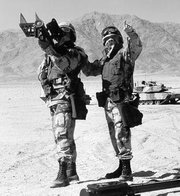FIM-92 Stinger
|
|
Stinger_system.JPG
Light to carry and easy to operate, the FIM-92 Stinger is a passive infrared homing/seek , shoulder-fired by a single operator and designed to attack aircraft at a range of up to 15,700 feet (4,800 m) and at heights from 600 to 12,500 feet (180 to 3,800 m). Classified as a surface-to-air missile, it can also be fired from helicopters.
It is manufactured by Raytheon Missile Systems and under license by Dornier in Germany. Raytheon designates the missile as a MANPADS (Man-Portable Air-Defense System). It is used by the military of the United States and by many other countries. Around 70,000 missiles have been produced.
The missile is 1.52 m long and 70 mm in diameter with 10 mm fins. It weighs 10.1 kg. The Stinger is launched by a small boost motor that pushes it a safe distance from the operator before engaging the main solid-fuel two-stage motor which accelerates it to a maximum speed of Mach 2.2 (750 m/s). The warhead is a 3 kg blast-fragmentation type with a proximity and an impact fuse.
| Contents |
History
Initial work on the missile was begun by General Dynamics in 1967 as the Redeye II. It was accepted for further development by the US Army in 1971 and designated FIM-92; the Stinger appellation was chosen in 1972. Because of technical difficulties that dogged testing, the first shoulder launch was not until mid-1975. Production of the FIM-92A began in 1978 to replace the FIM-43 Redeye. An improved Stinger with a new seeker, the FIM-92B, was produced from 1983 alongside the FIM-92A. Production of both the A and B types ended in 1987 with around 16,000 missiles produced.
The replacement FIM-92C had been developed from 1984 and production began in 1987. The first examples were delivered to front-line units in 1989. C-type missiles were fitted with a reprogrammable electronics system to allow for upgrades. The missiles which received a counter-measures upgrade were designated D and later upgrades to the D were designated G.
The FIM-92E or Block I was developed from 1992 and delivered from 1995 (certain sources state that the FIM-92D is also part of the Block I development). The main changes were again in the sensor and the software, improving the missile's performance against smaller and low-signature targets. An software upgrade in 2001 was designated F. Block II development began in 1996 using a new focal plane array sensor to improve the missile's effectiveness in "high clutter" environments and increase the engagement range to about 25,000 feet. Production is scheduled for 2004.
Since 1984 the Stinger has been issued to many US Navy warships for point defense, particularly in Middle Eastern waters.
The CIA helped supply nearly 500 Stingers to the mujahideen warriors fighting Soviet forces in Afghanistan. The Stingers are said to have downed nearly 300 Russian aircraft, including many helicopter gunships, before Soviet troops withdrew from Afghanistan in 1989. Also, as part of its effort to help overthrow Angola's government, the Reagan administration provided Stingers to UNITA rebels in the late 1980s. In both cases, efforts to recover missiles after the end of hostilities proved futile. There has been speculation that the reason the Stinger has not been used in further attacks is because the batteries that are needed for the launcher to function have expired.
Cost
In 2002, the United States sold 69 Stinger missiles and associated equipment (vehicle-mounted launch platforms, target acquisition radars, training equipment, et cetera) to Lithuania for USD 34 million [1] (http://bhhrg.org/LatestNews.asp?ArticleID=9). If half the cost of the contract was for the missiles themselves, the unit price would be about USD $250,000. The official flyaway cost is $76,000.
See also
External links
- Defense Update: Stinger VSHORAD Missile (http://www.defense-update.com/products/s/stinger.htm)

